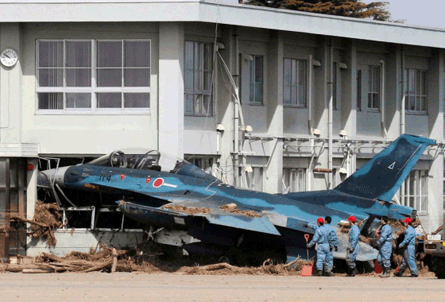On 11 March the sleepy Japanese airport at Sendai was the focus of the world. Aerial footage from Japanese television showed a tsunami of muddy seawater and debris, unleashed by a 9.0-magnitude offshore earthquake, sweeping across the airport, flooding runways and taxiways. The airport handles around 40 flights daily, but no commercial aircraft were present when the tsunami hit.
After the water subsided, pictures show the airport's parking lot littered with overturned cars and mud. Airbridges remained attached to the terminal building, although the apron was strewn with trees, vehicles, and other debris. Flightglobal was unable to contact airport officials to learn the true extent of the damage or to ascertain when it aims to reopen.
Aviation services firm Jamco operates two hangars at Sendai that provide maintenance services for small aircraft and business jets. The company also provides fixed-base operations at the airport.
None of the company's Sendai personnel were injured or lost their lives, and its facilities were undamaged by the tsunami, says Jamco. A number of light aircraft and helicopters were affected, but exact figures are unavailable. The company is compiling a report calculating the disaster's impact.
At the nearby Matsushima airbase, more airborne footage shows a Japanese air self-defence force Mitsubishi F-2 fighter jutting from a mud-filled hangar, its trailing surfaces covered with debris. Another F-2 was washed into an office building, its nose lodged in a first floor window.
Reports suggest that up to 18 F-2s could be complete write-offs. If true, this could put yet more urgency behind Japan's plans to replace its ageing McDonnell Douglas F-4 Phantoms.
 |
|---|
Possible Phantom replacements include the Eurofighter Typhoon and Boeing F-18 E/F Super Hornet. However, given the potential cost of rebuilding parts of the country, there will be questions over where defence procurement sits in the country's list of priorities.
The longer-term impact of the disaster is less certain, although major aerospace firms appear to have escaped unscathed.
Japan's aerospace sector is clustered around the city of Nagoya, on the main island of Honshu and several hundred kilometres from the earthquake's epicentre.
Japan's three first tier aerospace firms Mitsubishi, Kawasaki and Fuji Heavy Industries all have major roles in the Boeing 787 programme, and all have 787-related production facilities in Nagoya, as do the subcontractors that supply them.
The city was largely unaffected by the disaster, and some airlines, such as Lufthansa, even diverted flights to Nagoya's Chubu Centrair airport, which says it was undamaged by the earthquake. Chubu Centrair is also the primary airport that supports 747 Dreamlifter deliveries of 787 structures to Boeing's Everett, Washington and Charleston, South Carolina facilities.
In the immediate aftermath of the disaster, Boeing's 787 programme chief Scott Francher says there was "no major disruption" to suppliers following the earthquake and tsunami.
Additionally, Francher said the company's 787 Production Integration Centre in Everett had been monitoring the situation in Japan from the beginning of the catastrophe.
Fuji says its Nagoya-based 787 facility was unaffected and suffered no power cuts. Fuji's Utsonomiya components factory, however, is closer to the disaster area. It was undamaged, but continues to suffer periodic, scheduled power cuts lasting up to 6h a day.
Kawasaki and Mitsubishi say their plants in Nagoya are unaffected by the earthquake and are not suffering any production disruption.
- Additional reporting by Firdaus Hashim and Jon Ostrower
Source: Flight International
















